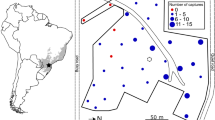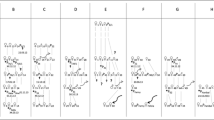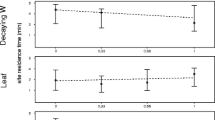Abstract
Socioecological models relate differences in feeding strategies to variation in the nature of female social relationships. Among the African forest guenons, females consume large quantities of fruit and other plant reproductive parts, resources which are thought to promote contest competition, yet these monkeys have been characterized as having agonistically undifferentiated relationships in which rank, if discernible at all, does not correlate with fitness benefits. To determine whether female relationships become more hierarchical under relevant ecological conditions, we monitored the adult females of two blue monkey groups (Cercopithecus mitis stuhlmanni) over a complete annual cycle in the Kakamega Forest, Kenya. Females competed aggressively for plant reproductive parts more often than any other resource type, and in both groups we detected linear dominance hierarchies. Nonetheless, agonism rates remained low throughout our study, and did not vary with changes in ecological conditions. Rather, when plant reproductive parts were scarce, subordinate females spent more time feeding and less time resting in an apparent attempt to compensate for a reduced efficiency of food intake. The effects of rank and food abundance were not reflected, however, in the distribution of grooming. The use of alternative feeding strategies appeared to blunt competition – females of all ranks were unlikely to be near others while feeding and spent more time consuming alternative resources when plant reproductive parts were scarce. The diverse diet of this species may allow females to avoid conflict so that dominance has only subtle effects that are difficult to detect. While socioecological models often simplify the connection between resources and female interactions, our results emphasize that the behavior of animals consuming particular resources, and not the resources themselves, are critical predictors of social patterns.
Similar content being viewed by others
References
Alexander RD (1974) The evolution of social behavior in groups. Annu Rev Ecol Syst 5:325–383
Altmann J, Muruthi P (1988) Differences in daily life between semiprovisioned and wild-feeding baboons. Am J Primatol 15:213–221
Barrett L, Henzie SP, Weingrill T, Lycett JE, Hill RA (1999) Market forces predict grooming reciprocity in female baboons. Proc Roy Soc Biol Sci Ser B 266:665–670
Barton RA (1993) Sociospatial mechanisms of feeding competition among female olive baboons, Papio anubis. Anim Behav 46:791–802
Barton RA, Byrne RW, Whiten A (1996) Ecology, feeding competition and social structure in baboons. Behav Ecol Sociobiol 38:321–329
Barton RA, Whiten A (1993) Feeding competition among female olive baboons, Papio anubis. Anim Behav 46:777–789
Bertram BCR (1980) Vigilance and group size in ostriches. Anim Behav 28:278–86
Boccia ML, Laudenslager M, Reite M (1988) Food distribution, dominance, and aggressive behaviors in bonnet macaques. Am J Primatol 16:123–130
Boinski S, Sughrue K, Selvaggi L, Quatrone R, Henry M, Cropp S (2002) An expanded test of the ecological model of primate social evolution: Competitive regimes and female bonding in three species of squirrel monkeys (Saimiri oerstedii, S. boliviensis and S. sciureus). Behaviour 139:227–261
Boydston EE, Kapheim KM, Szykman M, Holekamp KE (2003) Individual variation in space use by female spotted hyenas. J Mammal 84:1006–1018
Cavallini P, Nel JAJ (1995) Comparative behaviour and ecology of two sympatric mongoose species (Cynictis penicillata and Galerella pulverulenta). S Afr J Zool 30:46–49
Chapman CA, Chapman LJ, Cords M, Gathua JM, Gautier-Hion A, Lambert JE, Rode K, Tutin CEG, White LJT (2002) Variation in the diets of Cercopithecus species: Differences within forests, among forests, and across species. In: Glenn ME, Cords M (eds) The guenons: Diversity and adaptation in African monkeys. Kluwer Academic Publishers, New York, pp 325–350
Cheney DL (1992) Intragroup cohesion and intergroup hostility: The relations between grooming distributions and intergroup competition among female primates. Behav Ecol 3:334–345
Clutton-Brock TH (1988) Reproductive success in male and female red deer. In: Clutton-Brock TH (ed) Reproductive success: Studies of individual variation in contrasting breeding systems. University of Chicago Press, Chicago, pp 325–343
Clutton-Brock TH, Harvey PH (1977) Primate ecology and social organisation. J Zool, London 183:1–39
Cordeiro NJ (1992) Behaviour of blue monkeys (Cercopithecus mitis) in the presence of crowned eagles (Stephanoaetus coronatus). Folia Primatol 59:203–207
Cords M (1986) Interspecific and intraspecific variation in diet of two forest guenons, Cercopithecus ascanius and C. mitis. J Anim Ecol 55:811–827
Cords M (1987) Mixed-species association of Cercopithecus monkeys in the Kakamega Forest, Kenya. University of California, Publications in Zoology 117:1–109
Cords M (2000) Agonistic and affiliative relationships in a blue monkey group. In: Whitehead P, Jolly C (eds) Old world monkeys. Cambridge University Press, Cambridge, pp 453–479
Cords M (2002) Friendship among adult female blue monkeys (Cercopithecus mitis). Behaviour 139:291–314
Dasilva GL (1994) Diet of Colobus polykomos in Tiwai Island: Selection of food in relation to its seasonal abundance and nutritional quality. Int J Primatol 5:655–665
de Vries H (1995) An improved test of linearity in dominance hierarchies containing unknown or tied relationships. Anim Behav 50:1375–1389
de Vries H (1998) Finding a dominance order most consistent with a linear hierarchy: A new procedure and review. Anim Behav 55:827–843
Dunbar R, Sharman M (1984) Is social grooming altruistic?. Z Tierpsychol 64:163–173
Dunbar RIM (1988) Primate social systems. Croom Helm, London
Dunbar RIM (1992) Time: A hidden constraint on the behavioural ecology of baboons. Behav Ecol Sociobiol 31:35–49
Fashing PJ, Cords M (2000) Diurnal primate densities and biomass in the Kakamega Forest: An evaluation of census methods and a comparison with other forests. Am J Primatol 50:139–152
Gautier-Hion A (1988) The diet and dietary habits of forest guenons. In: Gautier-Hion A, Bourliere F, Gautier J, Kingdon J (eds) A primate radiation: Evolutionary biology of the African guenons. Cambridge University Press, New York, pp 257–283
Gautier-Hion A, Tutin CEG (1988) Simultaneous attack by adult males of a polyspecific troop of monkeys against a crowned hawk eagle. Folia Primatol 51:149–151
Gilchrist JS, Otali E (2002) The effects of refuse-feeding on home-range use, group size, and intergroup encounters in the banded mongoose. Can J Zool 80:1795–1802
Gore MA (1993) Effects of food distribution on foraging competition in rhesus monkeys, Macaca mulatta, and hamadryas baboons, Papio hamadryas. Anim Behav 45:773–786
Hall CL, Fedigan LM (1997) Spatial benefits afforded by high rank in white-faced capuchins. Anim Behav 53:1069–1082
Hemelrijk CK (1990) Models of and tests for reciprocity unidirectionality and other social interaction patterns at a group level. Anim Behav 39:1013–1029
Henzi SP, Barrett L (1999) The value of grooming to female primates. Primates 40:47–59
Holekamp KE, Smale L, Szykman M (1996) Rank and reproduction in the female spotted hyaena. J Reprod Fertil 108:229–37
Isbell LA (1991) Contest and scramble competition: Patterns of female aggression and ranging behavior among primates. Behav Ecol 2:143–155
Isbell LA, Enstam KL (2002) Predator (in)sensitive foraging in sympatric female vervets (Cercopithecus aethiops) and patas monkeys (Erythrocebus patas): A test of ecological models of group dispersion. In: Miller LE (ed) Eat or be eaten: Predator sensitive foraging among primates. Cambridge University Press, Cambridge, pp 154–168
Isbell LA, Pruetz JD (1998) Differences between vervets (Cercopithecus aethiops) and patas monkeys (Erythrocebus patas) in agonistic interactions between adult females. Int J Primatol 19:837–855
Isbell LA, Pruetz JD, Lewis M, Young T (1999) Rank differences in ecological behavior: A comparative study of patas monkeys (Erythrocebus patas) and vervets (Cercopithecus aethiops). Int J Primatol 20:257–272
Isbell LA, Pruetz JD, Young TP (1998) Movements of vervets (Cercopithecus aethiops) and patas monkeys (Erythrocebus patas) as estimators of food resource size, density, and distribution. Behav Ecol Sociobiol 42:123–133
Isbell LA, Young TP (2002) Ecological models of female social relationships in primates: Similarities, disparities, and some directions for future clarity. Behaviour 139:177–202
Janson CH (1988) Intra-specific food competition and primate social structure: A synthesis. Behaviour 105:1–17
Janson CH (1990) Ecological consequences of individual spatial choice in foraging groups of brown capuchin monkeys, Cebus apella. Anim Behav 40:922–934
Janson CH (1992) Evolutionary ecology of primate social structure. In: Smith EA, Winterhalder B (eds) Evolutionary ecology and human behavior. de Gruyter, New York, pp 95–130
Janson CH (2000) Primate socio-ecology: The end of a golden age. Evol Anthropol 9:73–86 DOI: 10.1002/(SICI)1520-6505(2000)9:2<73:AID-EVAN2>3.0.CO;2-X
Koenig A (2000) Competitive regimes in forest-dwelling Hanuman langur females (Semnopithecus entellus). Behav Ecol Sociobiol 48:93–109
Koenig A (2002) Competition for resources and its behavioral consequences among female primates. Int J Primatol 23:759–783
Koenig A, Beise J, Chalise MK, Ganzhorn JU (1998) When females should contest for food-testing hypotheses about resource density, distribution, size, and quality with Hanuman langurs (Presbytis entellus). Behav Ecol Sociobiol 42:225–237
Korstjens AH, Sterck EHM, Noë R (2002) How adaptive or phylogenetically inert is primate social behaviour? A test with two sympatric colobines. Behaviour 139:203–225
Lambert JE (1998) Primate digestion: Interactions among anatomy, physiology, and feeding ecology. Evol Anthropol 7:8–20 DOI: 10.1002/(SICI)1520-6505(1998)7:1<8:AID-EVAN3>3.0.CO;2-C
Lambert JE (2002) Resource switching and species coexistence in guenons: A community analysis of dietary flexibility. In: Glenn ME, Cords M (eds) The guenons: Diversity and adaptation in African monkeys. Kluwer Academic Publishers, New York, pp 309–323
Lawes MJ (1991) Diet of samango monkeys (Cercopithecus mitis erythrarchus) in the Cape Vidal Dune Forest South Africa. J Zool 224:149–173
Magliocca F, Querouil S, Gautier-Hion A (2002) Grouping patterns, reproduction, and dispersal in a population of sitatungas (Tragelaphus spekei gratus). Can J Zool 80:245–250
Mathy JW, Isbell LA (2001) The relative importance of size of food and interfood distance in eliciting aggression in captive rhesus macaques (Macaca mulatta). Folia Primatol 72:268–277 DOI:10.1159/000049948
Mitchell CL, Boinski S, van Schaik CP (1991) Competitive regimes and female bonding in two species of squirrel monkeys (Saimiri oerstedi and S. sciureus). Behav Ecol Sociobiol 28:55–60
Nakagawa N (1989) Feeding strategies of Japanese monkeys against deterioration of habitat quality. Primates 30:1–16
Palomares F, Delibes M (1993) Social organization in the Egyptian mongoose: Group size, spatial behaviour and inter-individual contacts in adults. Anim Behav 45:917–925
Payne HFP, Lawes MJ, Henzi SP (2003) Competition and the exchange of grooming among female samango monkeys (Cercopithecus mitis erythrarchus). Behaviour 140:453–472
Post DG, Hausfater G, McCuskey SA (1980) Feeding behavior of yellow baboons (Papio cynocephalus): Relationship to age, gender and dominance rank. Folia Primatol 3:179–195
Pruetz JD, Isbell LA (2000) Correlations of food distribution and patch size with agonistic interactions in female vervets (Chlorocebus aethiops) and patas monkeys (Erythrocebus patas) living in simple habitats. Behav Ecol Sociobiol 49:38–47
Pulliam HR, Caraco T (1984) Living in groups is there an optimal group size?. In: Krebs JR, Davies NB (eds) Behavioural ecology: An evolutionary approach, 2nd edn. Sunderland, MA, pp 122–147
Robinson JG (1981) Spatial structure in foraging groups of wedge-capped capuchin monkeys Cebus nigrivittatus. Anim Behav 29:1036–1056
Ron T, Henzi SP, Motro U (1996) Do female chacma baboons compete for a safe spatial position in a southern woodland habitat?. Behaviour 133:475–490
Rowell TE, Wilson C, Cords M (1991) Reciprocity and partner preference in grooming of female blue monkeys. Int J Primatol 12:319–336
Rudran R (1978) Socioecology of the blue monkeys (Cercopithecus mitis stuhlmanni) of the Kibale Forest, Uganda. Smithsonian Contrib Zool 249:1–88
Saito C (1996) Dominance and feeding success in female Japanese macaques, Macaca fuscata: Effects of food patch size and inter-patch distance. Anim Behav 51:967–980
Sterck EHM, Steenbeek R (1997) Female dominance relationships and food competition in the sympatric Thomas langur and long-tailed macaque. Behaviour 134:749–774
Sterck EHM, Watts DP, van Schaik CP (1997) The evolution of female social relationships in nonhuman primates. Behav Ecol Sociobiol 41:291–309
Strier KB (1994) Myth of the typical primate. Yearbook Phys Anthropol 37:233–277
Struhsaker TT (1978) Food habits of five monkey species in the Kibale Forest, Uganda. In: Chivers DJ, Herbert J (eds) Recent advances in primatology, vol 1. Academic Press, London, pp 225–248
Struhsaker TT (1997) Ecology of an African rain forest. University Press of Florida, Gainesville
Sugiyama Y, Ohsawa H (1982) Population dynamics of Japanese monkeys with special reference to the effect of artificial feeding. Folia Primatol 39:238–263
van Hooff JARAM, van Schaik CP (1992) Cooperation in competition: The ecology of primate bonds. In: Harcourt AH, de Waal FBM (eds) Coalitions and alliances in humans and other animals. Oxford University Press, Oxford, pp 357–389
van Noordwijk MA, van Schaik CP (1987) Competition among female long-tailed macaques, Macaca fascicularis. Anim Behav 35:577–589
van Schaik CP (1989) The ecology of social relationships amongst female primates. In: Standen V, Foley RA (eds) Comparative socioecology: The behavioural ecology of humans and other mammals. Blackwell Scientific Publications, Oxford, pp 195–218
van Schaik CP, Kappeler PM (1997) Infanticide risk and the evolution of male–female association in primates. Proc Roy Soc London, B 264:1687–1694
van Schaik CP, van Noordwijk MA (1988) Scramble and contest in feeding competition among female long-tailed macaques (Macaca fascicularis). Behaviour 105:77–98
White F (1983) The vegetation of Africa. UNESCO, Paris
Whitten PL (1983) Diet and dominance among female vervet monkeys (Cercopithecus aethiops). Am J Primatol 5:139–159
Wrangham RW (1980) An ecological model of female-bonded primate groups. Behaviour 75:262–300
Zuberbuhler K (2002) Effects of natural and sexual selection on the evolution of guenon loud calls. In: Glenn ME, Cords M (eds) The guenons: Diversity and adaptation in African monkeys. Kluwer Academic Publishers, New York, pp 289–308
Acknowledgements
We thank the Government of Kenya for permission to conduct research in the Kakamega Forest and the Institute for Primate Research (National Museums of Kenya) for local sponsorship. We are most grateful to Praxides Akelo and Benjamin Okalo for assistance observing monkeys in the field, to Benjamin Okalo and Wilberforce Okeka for help with identifying the local trees, and to the research teams of 1997 and 1998 for their observations of rare events. Dorothy Cheney, Julie Gros-Louis, Robert Harding and four anonymous reviewers provided helpful suggestions on earlier versions of this manuscript. This research was funded by the Anthropology Department of the University of Pennsylvania, the Wenner Gren Foundation, the L. S. B. Leakey Foundation, and two National Science Foundation grants to M.C. (SBR 95-23623, BCS 98-08273). The investigations described herein comply with the laws of the United States and Kenya.
Author information
Authors and Affiliations
Corresponding author
Additional information
Communicated by J. Setchell
Rights and permissions
About this article
Cite this article
Pazol, K., Cords, M. Seasonal variation in feeding behavior, competition and female social relationships in a forest dwelling guenon, the blue monkey (Cercopithecus mitis stuhlmanni), in the Kakamega Forest, Kenya. Behav Ecol Sociobiol 58, 566–577 (2005). https://doi.org/10.1007/s00265-005-0953-3
Received:
Revised:
Accepted:
Published:
Issue Date:
DOI: https://doi.org/10.1007/s00265-005-0953-3




